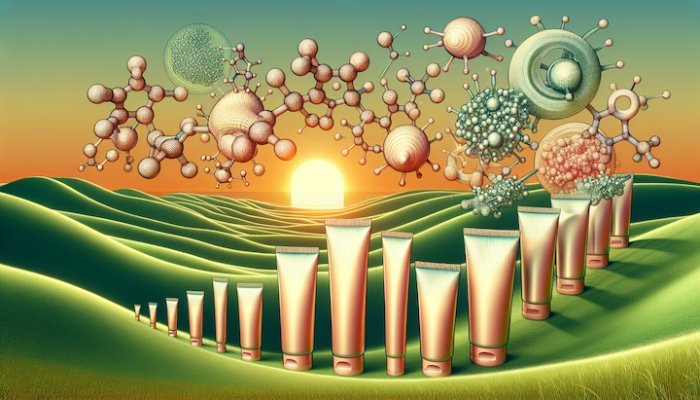Can progesterone help reduce or get rid of Fibroids?
Fibroids (uterine leiomyoma, myomas, fibromyoma) are benign, usually painless tumours found in the uterus, and are made of smooth muscle and connective tissue. They are characterised by overproduction of extracellular matrix. Although the aetiology is unknown, there's strong evidence they are caused by oxidative stress. Starting as microscopic bodies, they can grow to the size of a grapefruit or larger, sometimes filling the entire uterus.
There are five main types...
- submucosal
- subserosal
- intramural
- pedunculated
- cervical
From 15 to 20% of reproductive women develop fibroids. In the United States it's estimated that up to 70% of white women develop fibroids at some point by age 50; among African-American women, that number is closer to 80%. But they occur most frequently in women from the mid thirties on, affecting 30 to 40%. It's from about the age of thirty five that anovulatory cycles begin.
During these cycles when ovulation does not occur, progesterone levels drop sharply. This in effect allows oestrogen to rise. Oestrogen is a mitogenic, excitatory, inflammatory hormone and fibroids are directly related the the oestrogen environment. i.e. increased oestrogen leads to increased growth. HRT also statistically increases uterine fibroid volume.
Oestrogen's implication in fibroids is well known, so much so that women nearing Menopause are often advised to do nothing until menopause begins. With the drop in oestrogen levels the fibroids are absorbed back into the uterus.
As a study puts it...
"Progesterone is known to be not only a progestational compound but also to exert various anti-oestrogenic actions: it prevents oestrogen-induced abdominal fibroids, oestrogen-induced growth of the myometrium, and oestrogen-induced excessive luteinization."
Very heavy bleeding, clots, very long periods, with a short break in between are the hallmark of fibroids. They often cause irregular, sometimes painful periods, and pressure (due to their size and number).
Bleeding is generally the most common feature.
In less than 1% of cases, cancer can arise, usually forming leiomyosarcomas. The malignancy is more common in older, post menopausal women, who are found with rapidly growing tumours, bleeding, and some pelvic pain or discomfort.
Matrix metalloproteinases (MMPs) are proteolytic enzymes involved in tissue remodelling. They degrade collagen IV and stimulate chemokines and cytokines. Although limited activity of MMPs are essential, excessive activity is harmful to the healing process.
Excessive activity is involved in a wide variety of pathological processes, leading to several Inflammatory diseases. Including the spread of metastatic cancer cells, osteoarthritis, rheumatoid arthritis, atherosclerosis, pulmonary fibrosis, emphysema, neuroinflammation, tuberculosis, skin diseases, lupus, continual, heavy bleeding, endometriosis and fibroids.
Progesterone is a known inhibitor of MMPs, whereas oestrogen stimulates their secretion. Studies ranging from stroke, various cancers, brain inflammation following trauma, endometriosis, arthritis and more, where MMPs are involved, have found progesterone to inhibit their production.
This from one paper...
"These results suggest that activation of PR-B (progesterone receptor-B) by progesterone results in tumor suppression by inhibiting cell growth and invasiveness via suppression of the expression of MMPs."
MMPs are an essential part of Menstruation. When progesterone withdrawal occurs at the end of the monthly cycle, the level of MMPs rise. Their role is to break down the uterine lining and then bleeding commences.
But a high level of MMPs, plus a high level of oestrogen, which stimulates them further, will ensure continual bleeding. With oestrogen building the lining, and the MMPs breaking it down this vicious cycle needs to be broken. Progesterone does this safely and effectively.
Vitamin D as the hormone, 1,25(OH)(2) vitamin D3, suppresses the production of MMPs. But many studies have found low vitamin D levels are statistically associated with the occurrence of fibroids. Not only that, but the lower the level, the larger the fibroid. Sufficient vitamin D is associated with a reduced risk of uterine fibroids.
They are three to four times more common in African American women, who also have a ten times higher incidence of low vitamin D than white women. And yet few if any women are advised to take vitamin D and get their levels up high. In spite of studies finding vitamin D reduces the volume of fibroids.
In fact one 2011 study concludes with...
"Thus, hypovitaminosis D appears to be a risk factor for uterine fibroids."
N-acetyl cysteine (NAC) was shown to completely suppress MMP-2 and MMP-9 activity in one study on fibroids. A potent antioxidant, it's also effective for heavy bleeding, suppressing the same MMPs which break down the lining.
Low taurine levels are found in any dysfunctional uterine problem. i.e. irregular bleeding, endometrial cancer, cystic endometrial hyperplasia and fibroids.
Cranberry proanthocyanidins has been found to inhibit the production and activity of MMPs in a concentration-dependent manner.
As many studies have found, fibroids generally decrease during Pregnancy due to the high level of progesterone. But conversely they are also found to enlarge rapidly. This has been found to be due to the influence on cellular proliferation by hCG (human chorionic gonadotrophin).
hCG is produced in response to pregnancy, one of it's roles is to stimulate the corpus luteum to continue secreting progesterone. But in excess it also causes cells to proliferate. In the event of low progesterone production by the corpus luteum, this will not prevent fibroids from enlarging during pregnancy.
The following risk factors for Fibroids have been found...
- high levels of oestrogen
- oxidative stress
- hypertension
- diabetes
- pelvic inflammatory disease
- chlamydial infection
- IUD when it causes infectious complications
- perineal talcum powder use
- low serum adiponectin levels
- high levels of IGF-1
- tamoxifen
- genistein
- organochlorine pesticide exposure
Adiponectin is an adipocyte-secreted hormone, low levels are found in fibroids, Insulin Resistance and diabetes. There is also an inverse relation between adiponectin levels and body mass index.
Insulin-like growth factor-1 (IGF-1) promotes tissue growth, and plays a role in fibroids through stimulating proliferation and inhibiting apoptosis. Progesterone treatment significantly decreases IGF-1 in fibroids.
Moreover, IGF-1 enhances aromatase activity. Aromatase is a key enzyme in the biosynthesis of oestrogen. High levels of IGF-I lead to increased levels of oestrogen, which in turn stimulates further growth of the fibroids. Progesterone is an aromatase inhibitor.
High levels of IGF-1 are found in cows treated with bovine somatotropin (bST) or growth hormone. The majority of the milk produced in the States is from cows treated with bST, women drinking this milk are at increased risk of developing fibroids.
Tamoxifen, a weak oestrogen given to women to prevent recurrence of breast cancer, increases the risk of not only endometrial cancer, but also for uterine leiomyosarcoma. Furthermore it was found that tamoxifen causes the development of new fibroids and ovarian cysts.
Genistein, an isoflavone found primarily in legumes, with soy having the highest content, has weak oestrogenic activity. It's been found to stimulate the growth of fibroids by increasing IGF-1 and oestrogen receptor activity. Women eating soy or other legumes are at increased risk of fibroids.
Endocrine Disruptors, in particular the organochlorine pesticides, many of which mimic oestrogen, have been found to stimulate the proliferation of fibroid cells.
Natural treatment for Fibroids
The amount of progesterone needed will be dependent on the individual and the severity of the problem. Use between 100-200mg/day of progesterone. In severe cases start on no less than 200mg/day, vary the amount used following symptoms as a guide. If heavy, continual bleeding is a feature, 400mg/day is needed.
Consider taking at least 2000mg/day NAC, 2000mg/day taurine and at least 5000iu vitamin D (dependant on levels). And if heavy bleeding is an issue add 1000mg/day bioflavonoids.
Many women are under the mistaken impression that as they make only 5-20mg/day progesterone, some say up to 40mg/day, that that should be sufficient when supplementing. It is if there are no problems at all.
But once oestrogen rises, for whatever reason, far more progesterone is needed to overcome it. Some of the reasons for its rise are given above.
For more information see How to use progesterone cream
Before using progesterone it's essential to read the page on Oestrogen Dominance.
A vitamin D test is essential, see the following websites for more information on testing...
Conventional treatment for Fibroids
Current medical treatment is a hysterectomy, uterine artery embolisation (UAE) or laparoscopic myomectomy (LM) to remove them. Or anti-inflammatory drugs for the pain, and oral contraceptives to control the heavy bleeding. Fibroids are the leading cause for hysterectomy in the United States.
Website references
Reference papers
Int J Womens Health. 2013;5:93-100
Serum vitamin D3 level inversely correlates with uterine fibroid volume in different ethnic groups: a cross-sectional observational study
Epidemiology: May 2013 - Volume 24 - Issue 3 - p 447-453
Vitamin D and the Risk of Uterine Fibroids
Biology of Reproduction February 1, 2012
1,25-Dihydroxyvitamin D3 Treatment Shrinks Uterine Leiomyoma Tumors in the Eker Rat Model
Am J Obstet Gynecol 2011
Uterine Fibroids Cost the U.S. Billions, Study Finds
J Clin Endocrinol Metab. 2011 Feb 2
1,25-Dihydroxyvitamin D3 Reduces TGF-{beta}3-Induced Fibrosis-Related Gene Expression in Human Uterine Leiomyoma Cells
Fertil Steril. 2011 Jan;95(1):247-53
Vitamin D inhibits proliferation of human uterine leiomyoma cells via catechol-O-methyltransferase
The Open Women's Health Journal, 2011, 5, 1-6
Serum Taurine as a Marker of Endometrial Cancer
Fertil Steril. 2010 Nov;94(6):2421-3
Pregnancy-related fibroid reduction
J Cell Physiol. 2010 Mar;222(3):729-37
Upregulation of MMP-9 production by TNFalpha in keratinocytes and its attenuation by vitamin D
Endocrinology. 2010 Oct;151(10):4949-58
Insulin-like growth factor I enhances the expression of aromatase P450 by inhibiting autophagy
Fertility and Sterility Volume 91, Issue 5 , Pages 1919-1925, May 2009
Vitamin D inhibits myometrial and leiomyoma cell proliferation in vitro
JDR July 2009 vol. 88 no. 7 627-632
Cranberry Proanthocyanidins Inhibit MMP Production and Activity
CELL AND TISSUE BIOLOGY 2008, Volume 3, Number 1, 56-60
Activity of matrix metalloproteinases in normal and transformed mouse fibroblasts exposed to antioxidants
Hum Reprod. 2008 Aug;23(8):1873-83
A low concentration of genistein induces estrogen receptor-alpha and insulin-like growth factor-I receptor interactions and proliferation in uterine leiomyoma cells
Mol Endocrinol. 2008 Aug;22(8):1812-24
Progesterone receptor inhibits aromatase and inflammatory response pathways in breast cancer cells via ligand-dependent and ligand- independent mechanisms
Biochem Pharmacol. 2007 May 1;73(9):1434-45
Suppression of NF-kappaB activation by curcumin leads to inhibition of expression of cyclo-oxygenase-2 and matrix metalloproteinase-9 in human articular chondrocytes: Implications for the treatment of osteoarthritis
Biol Res. 2006;39(4):619-29
Lipid peroxidation and antioxidant status in blood of patients with uterine myoma, endometrial polypus, hyperplastic and malignant endometrium
International Journal of Gynecological Pathology 25(2):173-175, April 2006
Myxoid Leiomyosarcoma of the Uterus in a Patient Receiving Tamoxifen Therapy: A Case Report
Hum Reprod. 2004 Apr;19(4):815-21
Progesterone down-regulates insulin-like growth factor-I expression in cultured human uterine leiomyoma cells
Cancer Lett. 2004 Jun 25;209(2):237-43
Overexpressed progesterone receptor form B inhibit invasive activity suppressing matrix metalloproteinases in endometrial carcinoma cells
Gynecol Obstet Invest 2004;58:160-163
Aberrant Serum Adiponectin Levels in Women with Uterine Leiomyomas
Epidemiology 14(2):247-250, March 2003
Why is Parity Protective for Uterine Fibroids?
Maturitas. 2002 Sep 30;43(1):35-9
Effect of hormone replacement therapy on uterine fibroids in postmenopausal women--a 3-year study
Mol Cell Endocrinol. 2002 Oct 31;196(1-2):11-20
Transdominant suppression of estrogen receptor signaling by progesterone receptor ligands in uterine leiomyoma cells
The Internet Journal of Gynecology and Obstetrics TM 2002. Volume1 Number 2
Quick Review: Uterine Fibroids
Annals of the New York Academy of Sciences 955:139-146 (2002)
Paracrine Mediators of Endometrial Matrix Metalloproteinase Expression
Anticancer Res. 2001 Jan-Feb;21(1A):213-9
Inhibitory effect of N-acetylcysteine on invasion and MMP-9 production of T24 human bladder cancer cells
American Journal of Epidemiology 2001, Vol. 153, No. 1 : 11-19
Risk Factors for Uterine Leiomyoma: A Practice-based Case-Control Study. II. Atherogenic Risk Factors and Potential Sources of Uterine Irritation
Carcinogenesis, Vol. 22, No. 12, 2049-2052, December 2001
Protective effect of pregnancy for development of uterine leiomyoma
Toxicol Sci. 2000 Apr;54(2):355-64
Estrogenic effects of organochlorine pesticides on uterine leiomyoma cells in vitro
Mol Hum Reprod. 2000 Jun;6(6):523-8
HCG promotes proliferation of uterine leiomyomal cells more strongly than that of myometrial smooth muscle cells in vitro
Biochim Biophys Acta. 2000 Mar 16;1478(1):51-60
Matrix metalloproteinase inhibition by green tea catechins
Gynecologic and Obstetric Investigation Vol. 48, Suppl. 1, 1999
The Potential Role of Environmental Toxins in the Pathophysiology of Endometriosis
Steroids Volume 64, Issue 9, September 1999, Pages 648-653
Progesterone and transforming growth factor- coordinately regulate suppression of endometrial matrix metalloproteinases in a model of experimental endometriosis
Journal of the National Cancer Institute, Vol. 90, No. 23, December 2, 1998
Hormonal Etiology of Epithelial Ovarian Cancer, With a Hypothesis Concerning the Role of Androgens and Progesterone
Analyst. 1998 Dec;123(12):2429-35
Increased milk levels of insulin-like growth factor 1 (IGF-1) for the identification of bovine somatotropin (bST) treated cows
Am J Obstet Gynecol. 1998 Mar;178(3):457-61
Expression of gelatinase B by trophoblast cells: down- regulation by progesterone
Gynecol Endocrinol. 1998 Feb;12(1):29-34
Effects of estradiol and an aromatase inhibitor on progesterone production in human cultured luteal cells
Journal of Endocrinology, 1998, Vol 158, Issue 3, 401-407
Progesterone inhibits glucocorticoid-dependent aromatase induction in human adipose fibroblasts
Journal of Ultrasound in Medicine, 1998 Vol 17, Issue 11 699-703
Use of transvaginal ultrasonography to monitor the effects of tamoxifen on uterine leiomyoma size and ovarian cyst formation
J. Clin. Invest. Volume 99, Number 12, June 1997, 2851-2857
Suppression of Matrix Metalloproteinases Inhibits Establishment of Ectopic Lesions by Human Endometrium in Nude Mice
The Journal of Clinical Endocrinology & Metabolism May 1, 1997 vol. 82 no. 5 1409-1415
Production of Endometrial Matrix Metalloproteinases, but Not Their Tissue Inhibitors, is Modulated by Progesterone Withdrawal in an in Vitro Model for Menstruation
Biology of Reproduction, 1983, Vol 28, 1078-1089
Progesterone inhibits the induction of aromatase activity in rat granulosa cells in vitro
Nature 177 , 478 - 479 (10 March 1956)
Comparative Anti-oestrogenic Potencies of Progesterone and 17 alpha Hydroxyprogesterone
Nature 174 , 839 - 840 (30 October 1954)
Anti-oestrogenic Potencies of Various Progesterone Derivatives with Oxidation at C11
Cancer Research October 25, 1943
Comparative Antifibromatogenic Activity of Progesterone and Related Artificial Steroids
 Struggling with weight gain or not being able to shed excess mass? If you have addressed your diet and exercise regime then you may want to look into the role hormones play in the arena of weight mana…
Struggling with weight gain or not being able to shed excess mass? If you have addressed your diet and exercise regime then you may want to look into the role hormones play in the arena of weight mana… Finding natural solutions to hormonal problems is a quest for many women worldwide. Organic progesterone creams emerge as a favoured choice offering a natural balance without the complications attache…
Finding natural solutions to hormonal problems is a quest for many women worldwide. Organic progesterone creams emerge as a favoured choice offering a natural balance without the complications attache… Navigating perimenopause, a period when progesterone becomes crucial for a woman’s well-being, can be quite challenging as one grapples with an array of symptoms. From the age of around 35, the produc…
Navigating perimenopause, a period when progesterone becomes crucial for a woman’s well-being, can be quite challenging as one grapples with an array of symptoms. From the age of around 35, the produc…